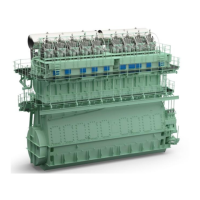Operation0750−1/A1
Winterthur Gas & Diesel Ltd.
4/ 18
Some consumption and replenishment of the system oil is necessary to keep the oil in
good condition.
If there is an important decrease in the flash point below the recommended value
shown above, WinGD recommends a replenishment of the oil charge.
By a replenishment, an increase in the system oil BN is prevented. A small increase
in BN is often an indication that the system oil consumption is low.
The open cup type of flash point test procedure (e.g. COC) must be used to decide if
some of the oil, or a full oil change is necessary. The closed cup type of flash point
test procedure (e.g. PMCC) can be used to monitor the system oil condition, but not
for oil change.
The FZG gear machine performance test (method A/8.3/90, ISO 14635−1) of the oil is
important if a new gear wheel is installed or was polished. This gives protection
against scuffing during the running-in of the gears.
If the system oil is in use for more than one year, the FZG performance of the oil must
be done to make sure that the performance is sufficient for the new or polished
gear(s).
You must do regular on-board checks of the BN and water content to get an early
indication of a lower oil quality.
2.3 Particle Size and Count
Particle size analysis can give useful data about the wear in an engine. Abrasive
particles in the oil can cause wear, thus the procedures must be carefully followed.
The requirements for particle size refers only to the hydraulic oil systems. These
systems operate the exhaust valve and the fuel and cylinder lubricating oil injection
systems, (i.e. the servo oil downstream of the fine filter, which is usually 10 mm
maximum sphere passing size). Some engines have a 25 mm maximum or other fine
filter.
The ISO 4406 particle count and size classes are applicable for the system oil
downstream of the filter and are given in Table 3.
2017−08
Lubricating Oils

